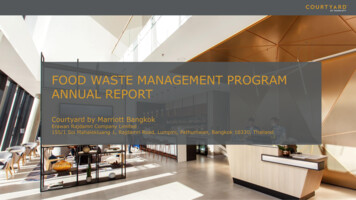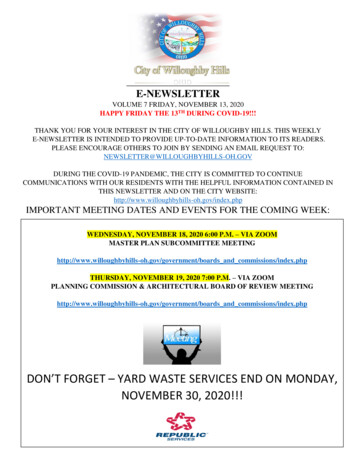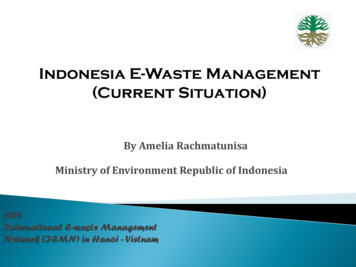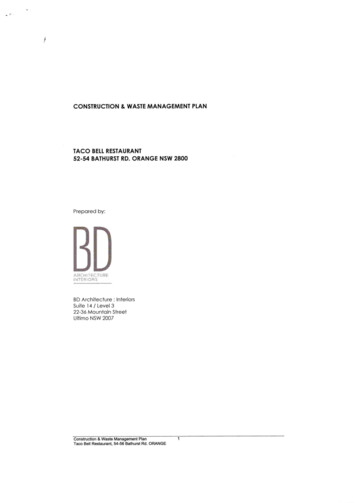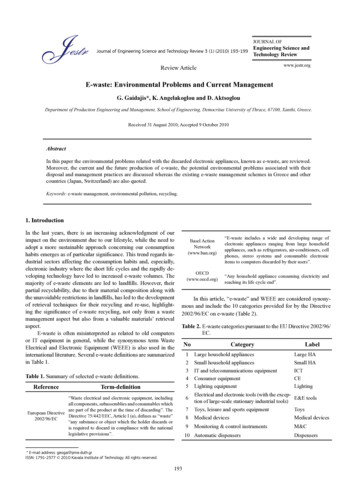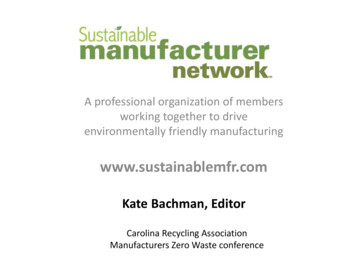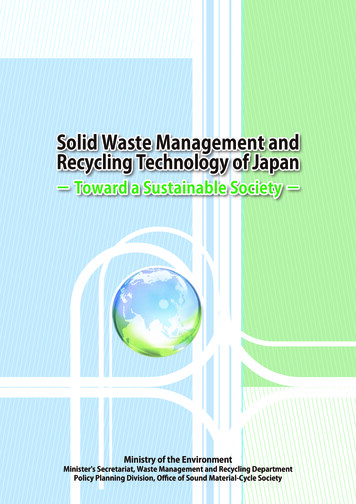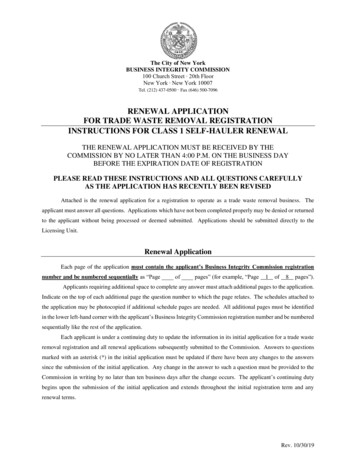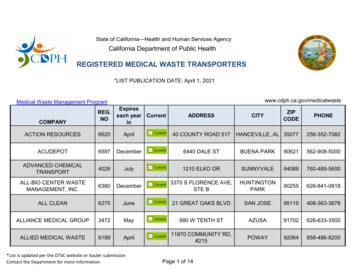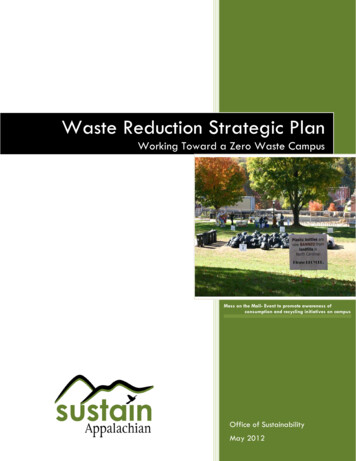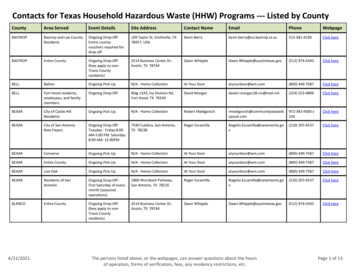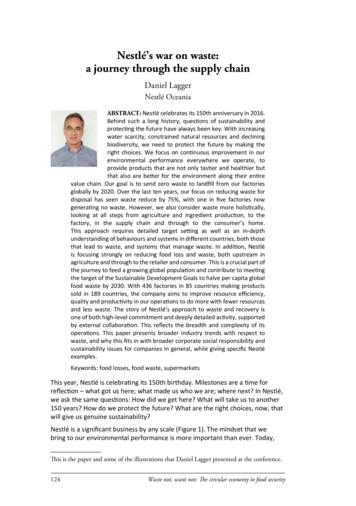
Transcription
Nestlé’s war on waste:a journey through the supply chainDaniel LaggerNestlé OceaniaABSTRACT: Nestlé celebrates its 150th anniversary in 2016.Behind such a long history, questions of sustainability andprotecting the future have always been key. With increasingwater scarcity, constrained natural resources and decliningbiodiversity, we need to protect the future by making theright choices. We focus on continuous improvement in ourenvironmental performance everywhere we operate, toprovide products that are not only tastier and healthier butthat also are better for the environment along their entirevalue chain. Our goal is to send zero waste to landfill from our factoriesglobally by 2020. Over the last ten years, our focus on reducing waste fordisposal has seen waste reduce by 75%, with one in five factories nowgenerating no waste. However, we also consider waste more holistically,looking at all steps from agriculture and ingredient production, to thefactory, in the supply chain and through to the consumer’s home.This approach requires detailed target setting as well as an in-depthunderstanding of behaviours and systems in different countries, both thosethat lead to waste, and systems that manage waste. In addition, Nestléis focusing strongly on reducing food loss and waste, both upstream inagriculture and through to the retailer and consumer. This is a crucial part ofthe journey to feed a growing global population and contribute to meetingthe target of the Sustainable Development Goals to halve per capita globalfood waste by 2030. With 436 factories in 85 countries making productssold in 189 countries, the company aims to improve resource efficiency,quality and productivity in our operations to do more with fewer resourcesand less waste. The story of Nestlé’s approach to waste and recovery isone of both high-level commitment and deeply detailed activity, supportedby external collaboration. This reflects the breadth and complexity of itsoperations. This paper presents broader industry trends with respect towaste, and why this fits in with broader corporate social responsibility andsustainability issues for companies in general, while giving specific Nestléexamples.Keywords: food losses, food waste, supermarketsThis year, Nestlé is celebrating its 150th birthday. Milestones are a time forreflection – what got us here; what made us who we are; where next? In Nestlé,we ask the same questions: How did we get here? What will take us to another150 years? How do we protect the future? What are the right choices, now, thatwill give us genuine sustainability?Nestlé is a significant business by any scale (Figure 1). The mindset that webring to our environmental performance is more important than ever. Today,This is the paper and some of the illustrations that Daniel Lagger presented at the conference.124Waste not, want not: The circular economy to food security
Lagger – Keynote: Nestlé’s war on waste: a journey through the supply chainFigure 1. Nestlé is a significant worldwide business that has been operating now for 150 years.we confront issues of increasing water scarcity, constrained natural resources,declining biodiversity, and climate change, so the importance of making the rightchoices could not be more clear. How we think about waste is obviously a keypart of this.Of course, reducing waste should be a no-brainer for every business. Waste hasa cost. Waste is things we have purchased or created that have cost us time,money and other resources. To not use them is to have invested resources insomething with no return. That makes no sense. This is something the entirefood and beverage industry knows.However, it is not enough to simply say we want to reduce waste. Rather, wehave to take an end-to-end look at our supply chain, upstream to basic researchand agriculture and right through to the retailer and on to the consumer(Figure 2). We need to deeply understand what waste looks like, how it comesabout, and how we can do better. This takes both an eye for detail, and creativethinking.Figure 2. Planning for no waste: set targets, measure, constantly review.Proceedings of the Crawford Fund 2016 Annual Conference125
Lagger – Keynote: Nestlé’s war on waste: a journey through the supply chainIn a world facing increasing constraints on natural resources, Nestlé has set thissimple but ambitious long-term goal: zero waste for disposal. We are makingprogress against a number of interim targets by preventing and minimising thewaste we generate in the first place, by avoiding food wastage and improvingresource efficiency along the value chain, and where possible we try to reusematerials and create value from them. It is not one project but hundreds, eventhousands, across Nestlé’s 436 factories, and out to the ends of our supply chain.Nestlé thinking globallyAccording to the Food and Agriculture Organization of the United Nations(FAO), about one-third of global food production is wasted worldwide each year(Figure 3). Either perfectly edible food is thrown in the bin, or food is lost when itspills, spoils, bruises or wilts before it reaches the consumer.In an age where 800 million people go hungry, the significance of that waste isextraordinary; the challenge for our industry no less so.Food waste causes 8% of human-produced greenhouse gas emissions. If itwas a country, this wasted food would be the world’s third highest emitter ofgreenhouse gases, behind China and USA, and the water needed to grow thisfood would fill Sydney Harbour 475 times.The United Nations’ 2030 Sustainable Development Goals acknowledge theseriousness of this problem. We particularly note Goal 12.3:‘By 2030, halve per capita global food waste at the retail andconsumer levels and reduce food losses along production andsupply chains, including post-harvest losses.’In response, in January 2016, our CEO Paul Bulcke joined a new coalition,Champions 12.3, to accelerate progress towards fulfilling this goal.Subsequently, we, together with our peers in the Consumer Goods Forum – acoalition of more than 400 of the world’s largest manufacturers, retailers andservice providers – resolved that forum members should halve food waste fromtheir own operations by 2025.Figure 3. Worldwide, food waste is an issue: resources invested for no return.126Waste not, want not: The circular economy to food security
Lagger – Keynote: Nestlé’s war on waste: a journey through the supply chainOne major hurdle to progress for both industry and government has been a lackof consistent guidance on how to reduce food waste. For that reason, Nestlé, asa company already measuring food waste, played a key role in developing thefirst global standard to help companies and governments reduce food loss andwaste (see also Lipinski, this voume). Members of this partnership include theConsumer Goods Forum, the FAO and the World Resources Institute.This standard, the Food Loss and Waste Accounting and Reporting Standard(FLW Protocol 2016), was launched in June at the 3GF Global Green GrowthForum in Copenhagen. It provides the first-ever set of global definitions andreporting requirements for companies, countries and others to consistently andcredibly measure, report on and manage food loss and waste. It has been hailedas a real breakthrough because, for the first time, countries and companieswill be able to quantify how much food is lost and wasted and where it occurs.Not only can they then report on it credibly and consistently, but identifyinghotspots will be the first step towards developing new strategies and monitoringprogress.This serious problem will require a great deal of focus at global and local levels,and for this reason, we are actively involved in a number of other multistakeholder initiatives to reduce food loss and waste.Nestlé acting locallyInternally, Nestlé’s Zero Food Wastage Taskforce coordinates our efforts todrive our food wastage initiatives across our value chain, share good practiceand guide multi-stakeholder initiatives. Last year, this Taskforce launchedour commitment to reduce food loss and waste, which addresses food lossand waste through responsible sourcing, zero waste for disposal in our sites,educating consumers and employees on reducing food waste, and engaging withkey stakeholders – such as regulators and scientists – to develop and implementsolutions.Worldwide, 54% of this lost and wasted food comes from the upstream valuechain – in production, handling, post-harvesting, and storage – and 46% comesfrom the downstream – in transformation, distribution and at consumption. Indeveloping countries, this skews more strongly towards production at the farm.These are also the countries where hunger is more likely to be a concern.At the farmAs a buyer of raw materials grown by more than 4,000,000 farmers, and withdirect buying relationships with 760,000 farmers, we have an extraordinarycapacity to support change. We can help reduce on-farm losses by helpingfarmers to farm more productively. For instance: in Vietnam, by helping coffee farmers to use the right amount of water – nottoo much, not too little, and to water at the right time to maximise theirproductivity without wasting water; in the Ivory Coast, by training cocoa farmers to harvest cocoa pods andferment and dry the cocoa in a way that preserves the cocoa and keeps thequality high – while teaching them to compost the waste for the future oftheir trees;Proceedings of the Crawford Fund 2016 Annual Conference127
Lagger – Keynote: Nestlé’s war on waste: a journey through the supply chain and in farming globally, by continuing to contribute to farm capacity-building– from propagation to post-harvest storage, farm animal health, care andwelfare, breeding better plants more fit for purpose, farm management andrecord keeping, and water conservation, irrigation and soil fertility.By contributing to the efficiency of their farms and a path to market, not only dowe help secure supplies of the agricultural raw materials we need, but we alsopositively impact society by supporting rural development, water conservationand food security and reducing food waste and farm losses at that critical stage.Storage, handling and transportAs food moves from the farm towards the factory, food companies are able tohelp farmers decrease post-harvesting food loss.To do this, Nestlé has created a new initiative called Vital First Mile, which bringsour colleagues with experience and expertise in transportation and storage toNestlé teams around the work to optimise that First Mile and minimise lossesbetween the farm gate and the factory gate.Reducing these post-harvest losses in our upstream value chain helps us ensuresupply of agricultural raw materials, and also supports rural development, waterconservation, and food security. For our suppliers, the Vital First Mile initiativewill help farmers, raw material pre-processing suppliers and logistics providersto reduce post-harvest and storage losses and thereby save costs.Our first Vital First Mile project in Qingdao, China, enabled Nestlé to successfullytransform dairy farming operations to dramatically decrease milk loss. Havingcollected milk in the area for 20 years, Nestlé decided to transform its modelwith a streamlined approach to milk collection which would reduce milk lossand collection costs while increasing quality and improving dairy farmingsustainability. Nestlé provided financial support to help farmers buy equipmentto improve cow productivity and milk quality and decrease waste milkproduction, then backed this up with regular training and technical support forfarmers on topics such as reducing milk loss and improving quality.128Waste not, want not: The circular economy to food security
Lagger – Keynote: Nestlé’s war on waste: a journey through the supply chainFigure 4. Better milk quality and less annual loss resulting fromthe Vital First Mile project at Qingdao, China.The outcomes have been significant. Bacteria counts in milk have dropped byover 50%, and the amount of milk lost to poor quality or because of antibioticuse has gone from US 102,000 worth of milk to no loss at all (Figure 4).This is a new project for us, but early signs are promising.In the factoryClearly, the part of the supply chain at which food companies have most controlover waste is in our own factories. Nestlé has set itself the objective of zerowaste for disposal across all our 436 factories by 2020, across all forms of waste.Waste for disposal is any material that leaves our factory for final disposal withno economic or ecological value such as landfilling and incineration withoutenergy recovery (Figure 5).We are well on the way: by the end of last year, 105 factories – that is 22% – hadachieved zero waste for disposal.Using best practice from those factories, we have developed a Zero Waste forDisposal Guideline. We recognise that every factory is different, every factoryhas different forms of waste and different challenges, and every location hasdifferent waste management opportunities. This guideline helps each site tounderstand the challenge they may face in their journey towards zero wastefor disposal; discover the recycling, recovery and reuse destinations of differentmaterials such as coffee grounds, tea leaves and coffee capsules; compareeconomic costs and benefits of achieving zero waste for disposal; and sharetools and examples of best practice implemented across the company globally tohelp all our sites prevent, reuse and recover waste for disposal and by-products.As a result, every Nestlé factory has projects to reduce waste, with the goal ofzero in mind.As manager of 12 very different factories across three countries, with manyforms of waste, I can confidently say that there is no one-size-fits-all approach.But I am impressed by the power that setting a hard target can have on theProceedings of the Crawford Fund 2016 Annual Conference129
Lagger – Keynote: Nestlé’s war on waste: a journey through t
factory, in the supply chain and through to the consumer’s home. This approach requires detailed target setting as well as an in-depth understanding of behaviours and systems in different countries, both those that lead to waste, and systems that manage waste. In addition, Nestlé is focusing strongly on reducing food loss and waste, both upstream in agriculture and through to the retailer .
